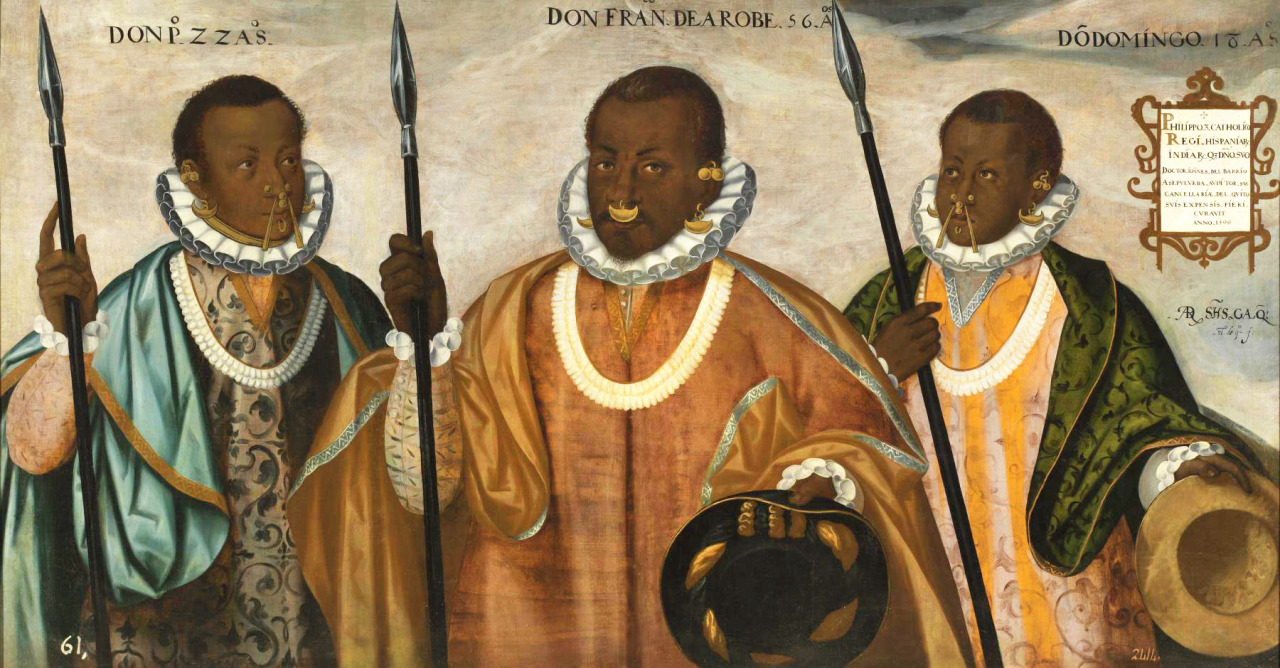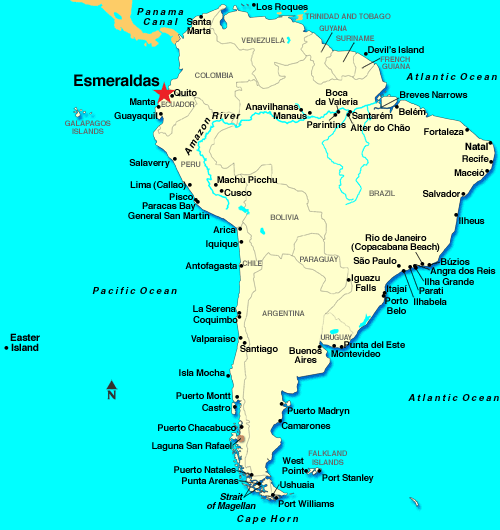Post by anansi on Dec 6, 2016 23:57:36 GMT -5

Africans of Esmeraldas, Ecuador: A Look at the 1599 Painting of Don Francisco de Arobe and His Two Sons
Some of us may have seen this painting before, I first came across it years ago in Ivan Van Sertima's book They Came Before Columbus. in it he had made a brief reference about a number of ship wreaked Africans that made their way inland and became governors in very short order, of a province of what was to become Ecuador, this then is their story.
n 1599, the painting was created by a Mative American painter by the name of Adrián Sánchez Galque. Like many original, fine works of art of this time, the painting is last known to exist in the collection of a European museum in Spain, the Museo de América de Madrid. When we first came upon this image from 1599, we became curious about the story behind the painting and the subsequent history of those Africans who continue at that placed called Esmeralda, Ecuador more than 400 years after the painting was commissioned.

Map of South America, noting location of Esmeraldas, Ecuador off Pacific Ocean coast.
We were not surprised that this painting may be located in Madrid. In 1599, the history of Madrid was not far removed from a time when the area was under complete ruler of the Moors. The Moors migrated from Northern Africa and settled the current city we call Madrid today. In fact, the historical record indicates that forts and a wall were built by the Moor around Madrid as early as 865 A.D. Before the city fell under Castillian rule in 1083, under leadership of Alfonso VI of Castile, the city was called Magerit by the Moors. From 1083, the time of Castillian rule, to 1599, the date the painting was created --was 516 years. From 1599 to 2014 is 415 years -- both periods being relatively short historical time spans. This is illustrated only to provide the reader a historical perspective. In 1544, Ecuador was reportedly under Spain's colonial rule. By 1564, Ecuador was dealing directly with Madrid.
Who are these three men in the painting? The historical accounts indicate the center figure is Don Francisco (de) Arobe. The other two men are his sons, Don Domingo, at the right, and Don Pedro, at the left. Each man holds a spears and wears an elaborate combination of Native American (indigenous) and Ibero-Spanish inspired clothing. On the actual painting, each man is identified by the title Don, a sign of respect in Latin-Hispanic culture at the time. It is evident from the gold jewelry and the title as Dons that the men were of high standing in the Esmeralda of 1599. The painting's inscription states as follows: "Doctor Juan del Barrio de Sepulveda, judge of the Real Audiencia of Quito, commissioned and paint for the painting, to your Majesty Phillip, Catholic King of Spain and the Indies in the year of 1599."
Who are these three men in the painting? The historical accounts indicate the center figure is Don Francisco (de) Arobe. The other two men are his sons, Don Domingo, at the right, and Don Pedro, at the left. Each man holds a spears and wears an elaborate combination of Native American (indigenous) and Ibero-Spanish inspired clothing. On the actual painting, each man is identified by the title Don, a sign of respect in Latin-Hispanic culture at the time. It is evident from the gold jewelry and the title as Dons that the men were of high standing in the Esmeralda of 1599. The painting's inscription states as follows: "Doctor Juan del Barrio de Sepulveda, judge of the Real Audiencia of Quito, commissioned and paint for the painting, to your Majesty Phillip, Catholic King of Spain and the Indies in the year of 1599."
The three men are also described by the painter as mulatos. This description may have been more of a reflection of the caste hierarchy distinction that existed in South America after the Europeans arrived, which created status based on the amount of European heritage held by an individual. Upon review of this painting, an argument can be made that a more appropriate title for these men would have been the Spanish term for Afro-Indian men, zambos, or for African men, negro.
Like the Spanish word negro, which mean black, the Spanish word zambos would creep into the Euro-English lexicon as "sambos." Unfortunately, the Anglo-European cultural baggage who translate the word into a negative connotation for people of African descent. But as we can see from this 1770 painting, zambos represented a further racial classification among the Europeans.
Like the Spanish word negro, which mean black, the Spanish word zambos would creep into the Euro-English lexicon as "sambos." Unfortunately, the Anglo-European cultural baggage who translate the word into a negative connotation for people of African descent. But as we can see from this 1770 painting, zambos represented a further racial classification among the Europeans.

Painting: Top inscription states "from a black man with a mulata produces a sambo," Indian school, circa. 1770.
In the book No Longer Invisible: Afro-Latin American Today, we are given some additional insights on the history of the region of Esmeraldas:
"Regional blackness as a force of self-liberation in Ecuador begins in Esmeraldas, and its origin occurs during a violent tropical storm and a movement of African rebellion. The documented history of Ecuador establishes the beginnings of Afro-Hispanic culture in what is now Esmeraldas, Ecuador, where a Spanish slaving ship ran aground in 1553. There a group of twenty-three Africans from the coast of Guinea, led by a black warrior named Antón, attacked the slavers and liberated themselves. Not long after, this group, together with other blacks entering the region, led by a ladino (Hispanicized black person) named Alonso de Illescas, came to dominate the region from northern Manabí north to what is now Barbacoas, Colombia. At this time (late sixteenth century) intermixture with indigenous peoples, to whom black people fled to establish their palenques (villages of self-liberated people - some fortified, some not), was such that their features were described as zambo (black-indigenous admixture), synonyms of which were negro (black) and mulato (mixed or hybrid black-white). ...
... By 1599 black people were clearly in charge of what was called "La República de Zambos" or "Zambo Republic". Zambo refers to people of colour who are descendants of Native Americans and African Americans. In that year a group of Zambo chieftains, said to represent 100,000 or more Zambo people of Esmeraldas, trekked to Quito to declare loyalty to Spain. An oil painting of these chiefs from the emerald land of the Zambo Republic is portrayed by the "Indian artist" Adrián Sánchez Galgue [sic]; it is reportedly the earliest signed and dated painting from South America."
By 1599, the date of this painting, we know that populations of settled Africans were residing in Esmeralda, Equador. region. Let's take a look back in time.
What of Esmeraldas, Ecuador now -- the home of our three Dons? This coastal city is in northwestern Ecuador and is one of the few predominantly black provinces, reportedly at 70 percent. It has the highest concentration of people of African descent in all of Ecuador. In terms of preserving its African cultural heritage, Esmeraldas' isolation may have been its saving grace.
"Regional blackness as a force of self-liberation in Ecuador begins in Esmeraldas, and its origin occurs during a violent tropical storm and a movement of African rebellion. The documented history of Ecuador establishes the beginnings of Afro-Hispanic culture in what is now Esmeraldas, Ecuador, where a Spanish slaving ship ran aground in 1553. There a group of twenty-three Africans from the coast of Guinea, led by a black warrior named Antón, attacked the slavers and liberated themselves. Not long after, this group, together with other blacks entering the region, led by a ladino (Hispanicized black person) named Alonso de Illescas, came to dominate the region from northern Manabí north to what is now Barbacoas, Colombia. At this time (late sixteenth century) intermixture with indigenous peoples, to whom black people fled to establish their palenques (villages of self-liberated people - some fortified, some not), was such that their features were described as zambo (black-indigenous admixture), synonyms of which were negro (black) and mulato (mixed or hybrid black-white). ...
... By 1599 black people were clearly in charge of what was called "La República de Zambos" or "Zambo Republic". Zambo refers to people of colour who are descendants of Native Americans and African Americans. In that year a group of Zambo chieftains, said to represent 100,000 or more Zambo people of Esmeraldas, trekked to Quito to declare loyalty to Spain. An oil painting of these chiefs from the emerald land of the Zambo Republic is portrayed by the "Indian artist" Adrián Sánchez Galgue [sic]; it is reportedly the earliest signed and dated painting from South America."
By 1599, the date of this painting, we know that populations of settled Africans were residing in Esmeralda, Equador. region. Let's take a look back in time.
What of Esmeraldas, Ecuador now -- the home of our three Dons? This coastal city is in northwestern Ecuador and is one of the few predominantly black provinces, reportedly at 70 percent. It has the highest concentration of people of African descent in all of Ecuador. In terms of preserving its African cultural heritage, Esmeraldas' isolation may have been its saving grace.
www.blackhistoryheroes.com/2014/07/africans-of-esmeraldas-ecuador-look-at.html

